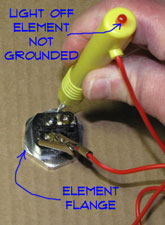 Testing for ground on water heater elements is a fairly simple test that only takes a few minutes. You should also 'test for continuity' at the same time. These tests require that you shut off the power to the water heater and remove the access panels.
Testing for ground on water heater elements is a fairly simple test that only takes a few minutes. You should also 'test for continuity' at the same time. These tests require that you shut off the power to the water heater and remove the access panels.
Not sure if this is the right place? See 'Troubleshooting for Electric Water Heaters' or 'Gas Water Heater Troubleshooting' for all of the water heater problems and resources.
What Does 'Testing for Ground' Mean?
Testing for ground on a water heater element is similar to 'testing for continuity'. However, the failure is completely different. The metal part of the heating element is kept separate from the metal in the tank by a plastic insulator. If this cracks or loosens, the water in the tank will cause it to short out.
If the current goes into the tank and back through the ground wire, the element fails to heat up and you don't have any hot water. So the term 'testing for ground' means to test and see if the element is grounding out into the metal on the tank.
Using the Right Tester
To check for ground you need to use a continuity tester. This is a battery operated tester that runs a small current through a device or wire to see if it is carrying electricity.
NOTE: This test can also be done with a multi meter. Multi meters are a little tricky to use and beyond the scope of this article. Check out Using a Multi meter, for more information.
You can purchase a simple water heater tester for around $10. This performs the same tests that you would use a multi meter for and it is a lot simpler to use. Do you already have a multi meter? Do you know how to use it? Great, you're all set.
Checking for Ground
Shutting Down the Power
The first thing you to do is make sure the power to the water heater is off. Go to the main panel and turn off the breaker for the Hot Water Heater, it should be marked on the legend.
It is very important to make sure the power is off. See the article on 'Shutting Down an Electric Water Heater' for more information. If you elements do turn out to be bad, you are going to have to follow all of the shut down steps.
Accessing the Water Heater Elements
An electric water heater has two elements, an upper and a lower. There are cover plates on the outside of the tank that are held in place by a couple of screws. Remove the cover plates to get to the element ends and the thermostats.
Typically the elements are below the thermostats. The upper thermostat will have a red reset button on it.There may be some insulation that needs to be pushed back out of the way. See the picture to help you identify the element.
Testing the Element for Ground
Checking ground on water heater elements if similar to testing the element. Make sure the power if off before beginning. Double check with a voltage tester.
Similar to Step One, the power needs to be off and the wires removed. Clamp one of the terminals to one of the lugs on the element. Touch the other lead to the metal element flange. This time no light is good.
If the light glows it means that the element is grounding out and needs to be replaced.
The Element Passed - Next Steps
Passing this test does not necessarily mean that you are out of the woods. Obviously, you are here because you either don't have enough hot water or you have no hot water. So, if the element passed the continuity test, there is still something wrong.
You will also need to test and see if you element is maintaining continuity. See the article, 'Testing a Water Heater Element for Continuity'. This is another simple test that determines whether or not the electrical current is passing through the element correctly. If power fails to go through the element, it will not heat up.
What If the Test Fails?
If the 'ground' test fails, the element is shorting out and will need to be replaced. There are no other options, elements cannot be repaired and there are no replaceable parts
You need to test both elements to see if they are both bad. Perform the 'ground' test on the other element to make sure it is not shorting out.
Replacing the Elements
What If Only One Element Failed?
New elements will cost between $15 and $40, so there is a cost consideration when only one is bad.
With that said, there is some common sense to be applied here. If only one element has gone bad it is very likely that the other one is not far behind. There is a fair amount of work involved to change one element. It makes sense to replace both of them at the same time.
Purchasing and Installing Elements
Replacing the elements is a job that requires draining the tank. You will want to see the article 'Installing Electric Water Heater Elements' for complete instructions on performing.

